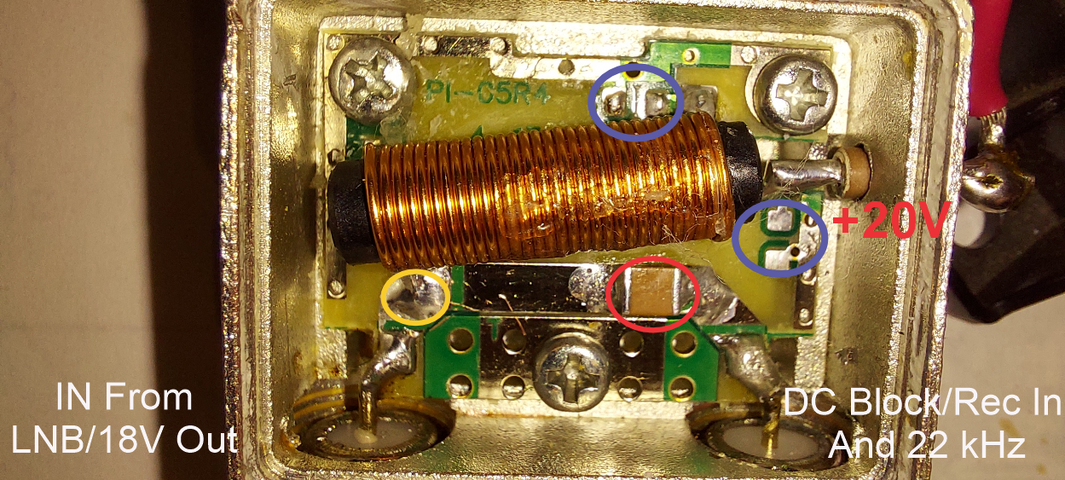Like the subject says. Wondering how it's usually done. I see tek has a 13/18 volt switch. I just refuse to buy anything from him.
Other searches come up a bit blank. It might be covered in the archives here but that's some deep searching.
In the interim. Although it might not be kosher. I was messing around and found my own solution w/o buying more stuff.
I use a 8X1 diseqc switch to select between C and Ku on my mio. For blind scans of unknown sats. when initially setting them up.
I edited the satellites.xml file to make a dummy that I could set to not move the dish.
Also a few years ago I found that I needed to nudge the dish a few clicks on 131W for different tp's.
These work:
<sat name="Test C-band Transponders" flags="1" position="-1775">
And for the dish 'nudge'....
<sat name="131.0W C-band AMC 11" flags="1" position="-1311">
<sat name="131.0W C-band AMC 11 *" flags="1" position="-1312">
Names edited so I know what I'm on. And numbers in red exclusive so I can set my dish mover memory slot.
So. It looks like it will work. I'm getting my 'guns loaded'. More on that.
Make duplicate entries in the xml.
Signify H, V tp's by appending, let's say....
<sat name="131.0W H C-band AMC 11" flags="1" position="-1311">
include only horiz. tp's in it and add new blind scanned findings.
<sat name="131.0W V C-band AMC 11" flags="1" position="-1313">
only vert. tp's in it. same for new scans.
Follow me? In Tuner setup set Port 1 for C band and voltage at 18 volts for the horiz. lnb.
Port 2 for C band, 18 volts for the vert. lnb.
And Port 3 for my sidecar ku lnbf.
Only 1 coax needs to be added to get everything down one wire to the house.
Any suggestions? A better and reliable way?
An old buddy/plumber just bought the home of the CATV owner before being bought out by the big guys.
He called me up and asked me if I wanted to look through the old stuff before he hauled it out for junk.
Boxes and boxes of new tubes. Mostly for RF amps. A mess of rectifier tubes.
And few few old boxes of dish components. Assorted Norsat lnbs. Need testing. Some look new. Others are crusty.
And a bunch of ortho feeds. I snagged a Harvard Scientific and CM. The rest are pretty crusty and weathered and pitted. Some scalars.
Tickled? Oh yeah.
Used my friends glass bead blaster. Looked up another one and he's going to powder coat them.
The plumber isn't in a big hurry to get rid of everything. But it will go.
Other searches come up a bit blank. It might be covered in the archives here but that's some deep searching.
In the interim. Although it might not be kosher. I was messing around and found my own solution w/o buying more stuff.
I use a 8X1 diseqc switch to select between C and Ku on my mio. For blind scans of unknown sats. when initially setting them up.
I edited the satellites.xml file to make a dummy that I could set to not move the dish.
Also a few years ago I found that I needed to nudge the dish a few clicks on 131W for different tp's.
These work:
<sat name="Test C-band Transponders" flags="1" position="-1775">
And for the dish 'nudge'....
<sat name="131.0W C-band AMC 11" flags="1" position="-1311">
<sat name="131.0W C-band AMC 11 *" flags="1" position="-1312">
Names edited so I know what I'm on. And numbers in red exclusive so I can set my dish mover memory slot.
So. It looks like it will work. I'm getting my 'guns loaded'. More on that.
Make duplicate entries in the xml.
Signify H, V tp's by appending, let's say....
<sat name="131.0W H C-band AMC 11" flags="1" position="-1311">
include only horiz. tp's in it and add new blind scanned findings.
<sat name="131.0W V C-band AMC 11" flags="1" position="-1313">
only vert. tp's in it. same for new scans.
Follow me? In Tuner setup set Port 1 for C band and voltage at 18 volts for the horiz. lnb.
Port 2 for C band, 18 volts for the vert. lnb.
And Port 3 for my sidecar ku lnbf.
Only 1 coax needs to be added to get everything down one wire to the house.
Any suggestions? A better and reliable way?
An old buddy/plumber just bought the home of the CATV owner before being bought out by the big guys.
He called me up and asked me if I wanted to look through the old stuff before he hauled it out for junk.
Boxes and boxes of new tubes. Mostly for RF amps. A mess of rectifier tubes.
And few few old boxes of dish components. Assorted Norsat lnbs. Need testing. Some look new. Others are crusty.
And a bunch of ortho feeds. I snagged a Harvard Scientific and CM. The rest are pretty crusty and weathered and pitted. Some scalars.
Tickled? Oh yeah.
Used my friends glass bead blaster. Looked up another one and he's going to powder coat them.
The plumber isn't in a big hurry to get rid of everything. But it will go.



